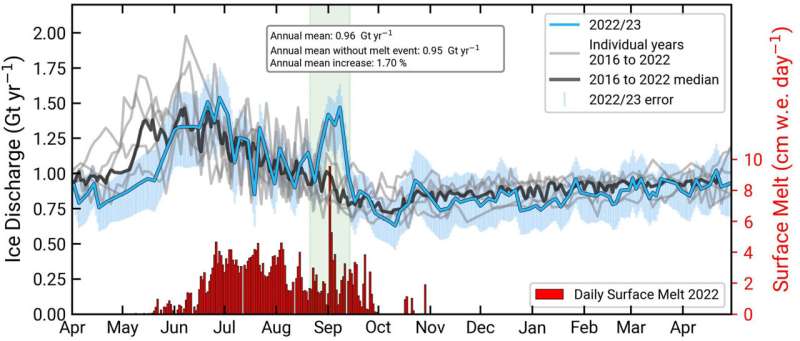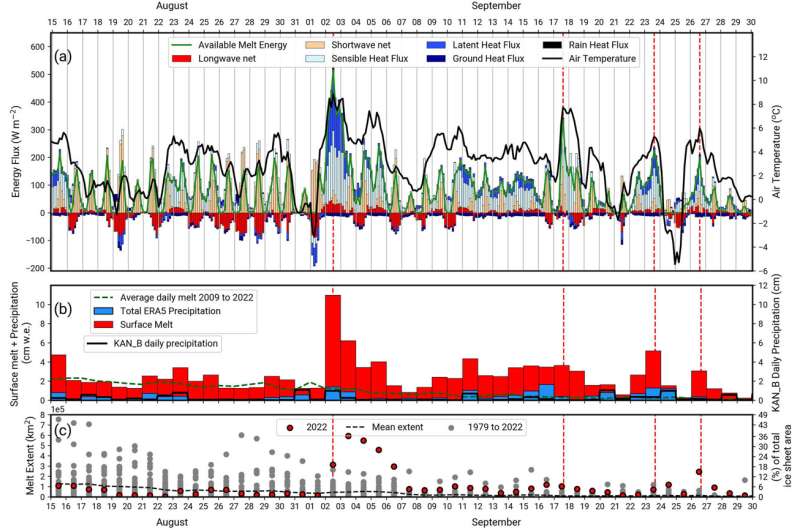
Ice melting has become an ever-pressing concern in recent decades as climate change has brought evocative images of lone polar bears floating on unsustainable small blocks of sea ice. Yet, the consequences are far-reaching in terms of freshening of seawater altering marine ecosystems, sea level rise exacerbating flooding and reduction of ice-albedo feedbacks that further modify Earth’s temperature.
New research, published in Geophysical Research Letters, has investigated the impact of late-season melting of the Greenland Ice Sheet to ascertain its effect on ice flow. This reflects the influence that surface melting has on modifying the ice sheet’s movement, potentially transporting ice more rapidly to lower elevations that are warmer, thus encouraging higher melt rates.
Ryan Ing, a Ph.D. researcher at the University of Edinburgh, UK, and colleagues focused on melt events occurring during 2022, a year that experienced seasonal air temperatures higher than previously recorded for the Greenland Ice Sheet in the late melt season.
Explaining the motivation behind their work, Ing said, “As the climate warms, we’re noticing more frequent periods of intense surface melting on the Greenland Ice Sheet, especially towards the end of the summer. During this time, the ice sheet’s movement becomes particularly responsive to spikes in surface melting, potentially moving more ice to lower elevations where air temperatures are higher.
“Our study focused on analyzing multiple intense melting events that occurred in late summer 2022 and their effect on the annual movement of the ice sheet. Despite observing a large acceleration in ice motion, this acceleration was short-lived, lasting only a few days, and did not significantly impact the overall annual motion of the ice sheet.”
“While these late-summer melt events may not pose a major concern for increased ice motion, our findings highlight their significant role in intensifying surface melting on the ice sheet.”
Using a record of satellite imagery spanning 5 years, the scientists studied 7 glaciers in west Greenland terminating both on land and in the ocean, combining ice velocities obtained from GPS and the Sentinel-1 space satellite with meteorological data from weather stations.
In 2022, the west Greenland Ice Sheet experienced the largest daily run-off in the late-melt season (late August onwards) since 1950. A succession of melt events occurred extending across ~37% of the ice sheet’s area due to an atmospheric river bringing warm air over the ice sheet that caused surface melting, peaking at 9.6 cm water equivalent per day.
During these events, one of the weather stations at an elevation of 1823 m on the ice sheet recorded a rapid air temperature increase from -17.7 °C to 2.7 °C in 24 hours.

These melt events resulted in the subglacial drainage system becoming overwhelmed by surface meltwater, lubricating the base of the glacier by increasing basal water pressure. Consequently, a decrease in basal friction led to a temporary increase in the velocity of the ice sheet’s motion by up to ~240% compared to pre-event velocities, reaching a maximum of 236 m y-1.
However, as meltwater supply increases through summer, larger subglacial channels develop, which increases their carrying capacity and reduces the lubrication effect on the base of the glacier, thus slowing its motion.
Further explaining the differing impacts of seasonal melting on the Greenland Ice Sheet’s subglacial drainage system, Ing said, “During the late melt season, the channels beneath the ice, which transport meltwater, gradually contract as surface melting decreases. Therefore, when a substantial surge in surface melt occurs during this period, such as from an atmospheric river event or cyclonic weather system, these channels become overwhelmed.”
“This leads to a rapid increase in basal water pressure, inducing accelerations in ice flow.”
“In contrast, during the peak of the melt season in summer, there is continuous surface melting and water flowing through the channels, which enlarges them. Consequently, when there is a melt event during this time of year, the larger channels can more easily accommodate the extra meltwater, resulting in less pronounced increases in basal water pressure and ice motion.”
Due to this efficiency of the subglacial drainage system and the transient nature of the accelerations in ice motion, the study found that the annual ice discharge of the ice sheet was not significantly impacted by changes in ice motion, with an increase (and therefore loss of ice mass) of ~4.5% combined for land and marine-terminating glaciers (0.044 Gt ice, compared to mean annual ice discharge of 0.979 Gt y-1 for 2016-2022).
What was significant, however, was the increase in total annual runoff (the amount of surface melting the ice sheet experiences in a year), which increased by ~24% because of these brief late-season melt events.
While this study suggests that the increase in annual ice discharge from these late-season melt events will not be a primary factor in ice sheet mass loss, the increase in meltwater runoff from such events is critical and significant. The transient late-season melt events of 2022 increased the annual mass loss from melt by an order of magnitude more than from the rather minimal ice acceleration.
This is especially important given that 50% of the entire Greenland Ice Sheet’s annual mass loss is due to meltwater runoff. The effects of enhanced late melt-season events may, therefore, become increasingly important in the decades to come as Earth’s climate continues to warm.
Ing concluded that the results of the study might be translated to other ice sheets and glaciers globally, highlighting the importance of further research in this field, “While the specific findings of this study pertain to the Greenland Ice Sheet, similar behavior is likely to occur at other glaciers and ice sheets that also undergo a seasonal cycle in ice motion linked to the seasonal cycle of surface melt.”
“This includes alpine glaciers, high arctic ice caps, and the glaciers on the Antarctica peninsula, which are experiencing increasing amounts of seasonal surface melt due to climate change.”
More information:
Ryan N. Ing et al, Minimal Impact of Late‐Season Melt Events on Greenland Ice Sheet Annual Motion, Geophysical Research Letters (2024). DOI: 10.1029/2023GL106520
© 2024 Science X Network
Citation:
Greenland Ice Sheet motion minimally impacted by late-season melting, study finds (2024, March 17)
retrieved 17 March 2024
from https://phys.org/news/2024-03-greenland-ice-sheet-motion-minimally.html
This document is subject to copyright. Apart from any fair dealing for the purpose of private study or research, no
part may be reproduced without the written permission. The content is provided for information purposes only.







